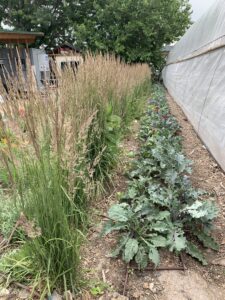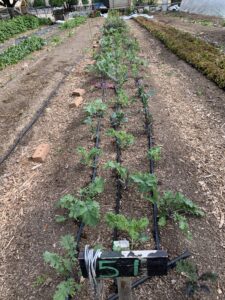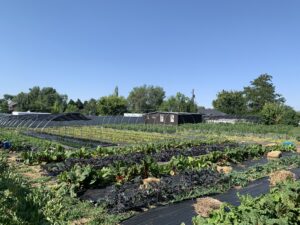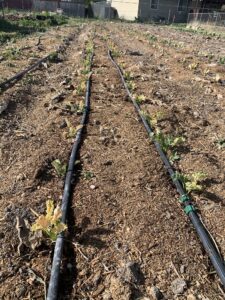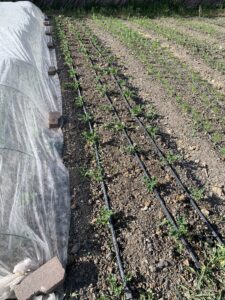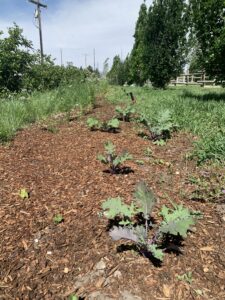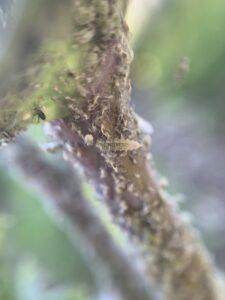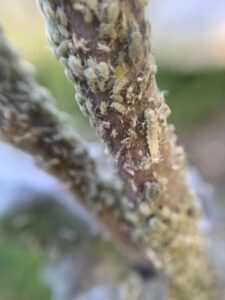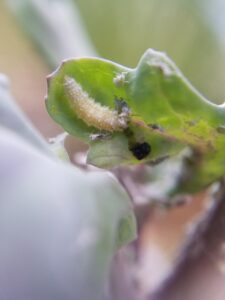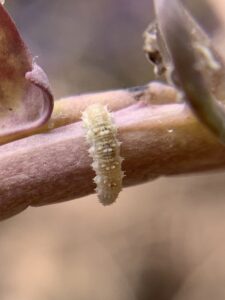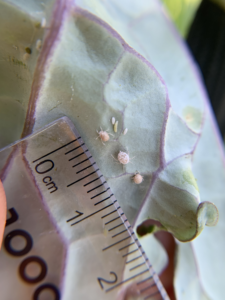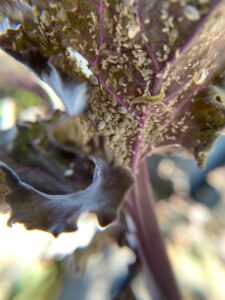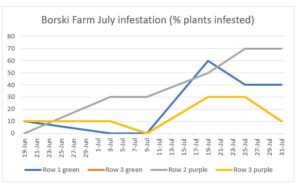Final report for OW18-007
Project Information
Our project seeks to expand the adoption of Conservation Biological Control practices for aphid
management on vegetable farms in northern Utah and the Intermountain West. Most farmers in
the region are faced with significant hurdles in learning and upfront costs required to implement
such practices. Aphid control is a fruitful “introduction” to Conservation Biological Control as
aphids have many natural enemies, and are a persistent problem for vegetable growers. Cabbage
aphid problems in particular have increased in recent years, as more farmers in the region grow
kale and other brassica crops year-round to meet customer demand.
Our project will establish aphid-control hedgerows at six farms, three of which will be used as
demonstration sites. Hedgerows will be evaluated for their potential to attract
natural enemies of cabbage aphid and to reduce aphid damage to cole crops, using associated
control plots (at varying distances from hedgerows) for comparison.
Education and outreach components of the project focus on building knowledge and visibility of
Conservation Biological Control practices at the grassroots level, and on making connections
among urban vegetable growers and the ways they implement Conservation Biological Control strategies in our region. We will extend Conservation Biological Control education and the results of this study to growers throughout
the Intermountain region with USU Extension or other publications, with an emphasis on the cost-benefit analysis of incorporating long-term Conservation Biological Control strategies such as hedgerows for pest control.
Our project attempts to lower the barriers to adoption of Conservation Biological Control
practices by emphasizing 1) that Conservation Biological Control is just formalizing and expanding on practices many farmers are already implementing, 2) Conservation Biological Control plants can be chosen for their direct profit potential (culinary or medicinal herbs, seeds, or bouquets for sale), and 3) the multiple resource conservation benefits of hedgerows specifically (e.g., reducing soil erosion, filtering runoff, preventing weed encroachment).
Objective 1. Evaluate whether hedgerows attract natural enemies of cabbage aphid
Objective 2. Evaluate whether fewer cole crops reach economic loss thresholds with
hedgerows
Objective 3. Use established hedgerows and outcomes of this study (Objectives 1 and 2) to
support broader education goals with Conservation Biological Control through
presentations to urban and small-acreage vegetable farmers.
Objective 4. Encourage grower-to-grower information exchange regarding Conservation
Biological Control with workshops or farm tours at demonstration farm sites.
Cooperators
Research
(OBJECTIVE 1A) Establishing Hedgerows
Site 1 (Green Phoenix Farm)
SPRING-FALL 2018
Site 1 (Green Team Farm). A 55 ft x 10 ft block was chosen for the hedgerow, along/directly adjacent to a 60-ft long greenhouse. The area had been used for storage and was compacted with low fertility soils, and few weeds. Topography was generally flat, but for the purposes of water catchment/conservation the area was sculpted to slope slightly downhill away from the greenhouse to capture runoff from the roof, and allow runoff to flow across the planting. A berm was constructed around three sides of the planting, and a pathway between the greenhouse edge and the planting for access. Plant choices: drought-tolerant mix of grasses, shrubs, and flowering perennials to provide continuous food and shelter for beneficial insects. Plants also selected to provide a yearly source of herbs and farmscaping perennials (most likely the grasses, most easily divided) to sell or add more beneficial insect habitat to the farm.
FALL 2018: To prepare the site, the site was irrigated for 24 hours, soil was then loosened with a broadfork, and approximately 2" of bark fines were spaded into the planting area. Plants were installed followed by installation of six Netafim irrigation lines (layout shown in photos). Species include feather reed grass, blue gramma grass, rabbitbrush, Russian sage, catmint, alyssum, candytuft, echinacea, black eyed susan, goldenrod, licorice mint hyssop, butterfly weed, and purple aster.
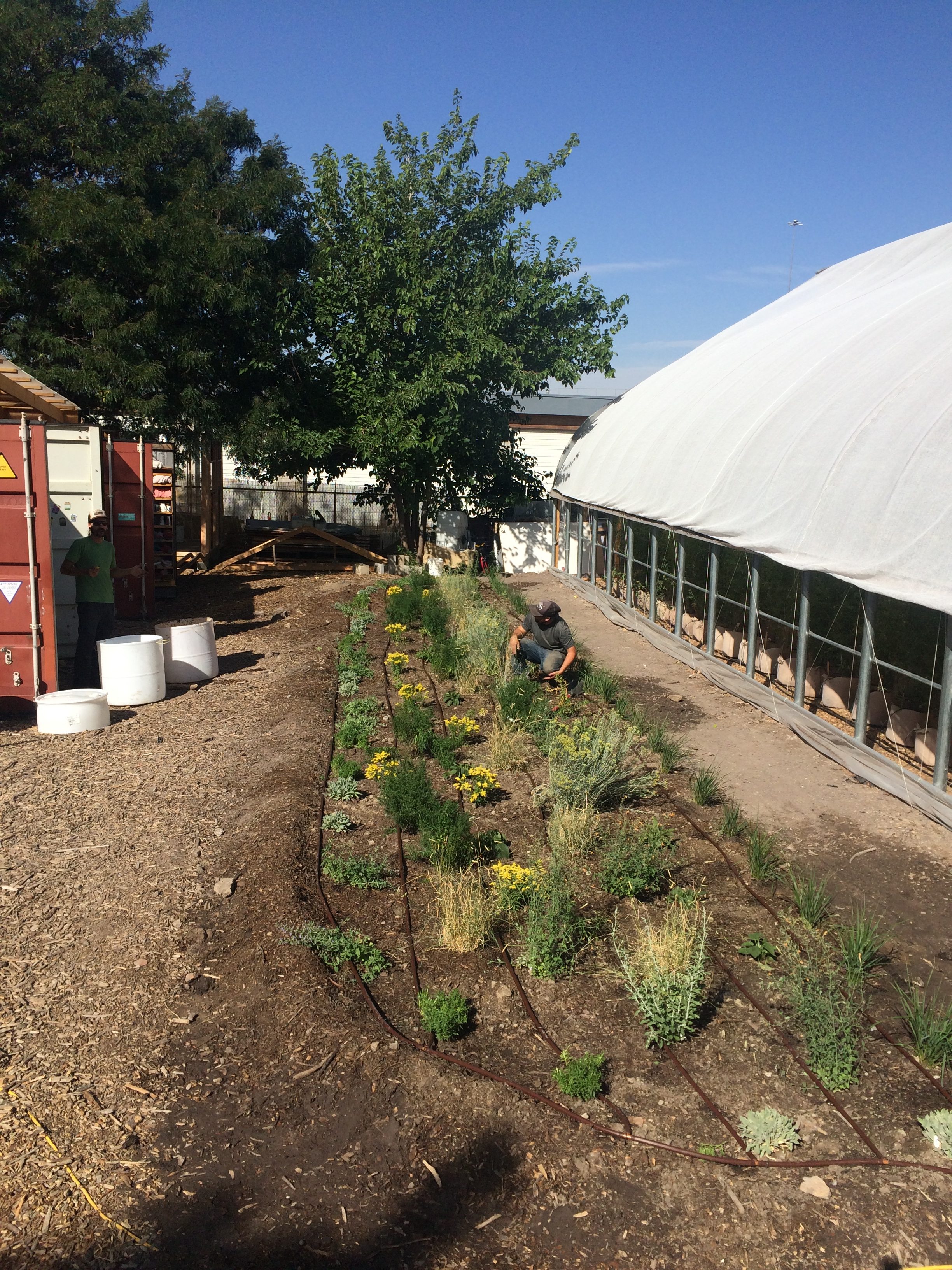
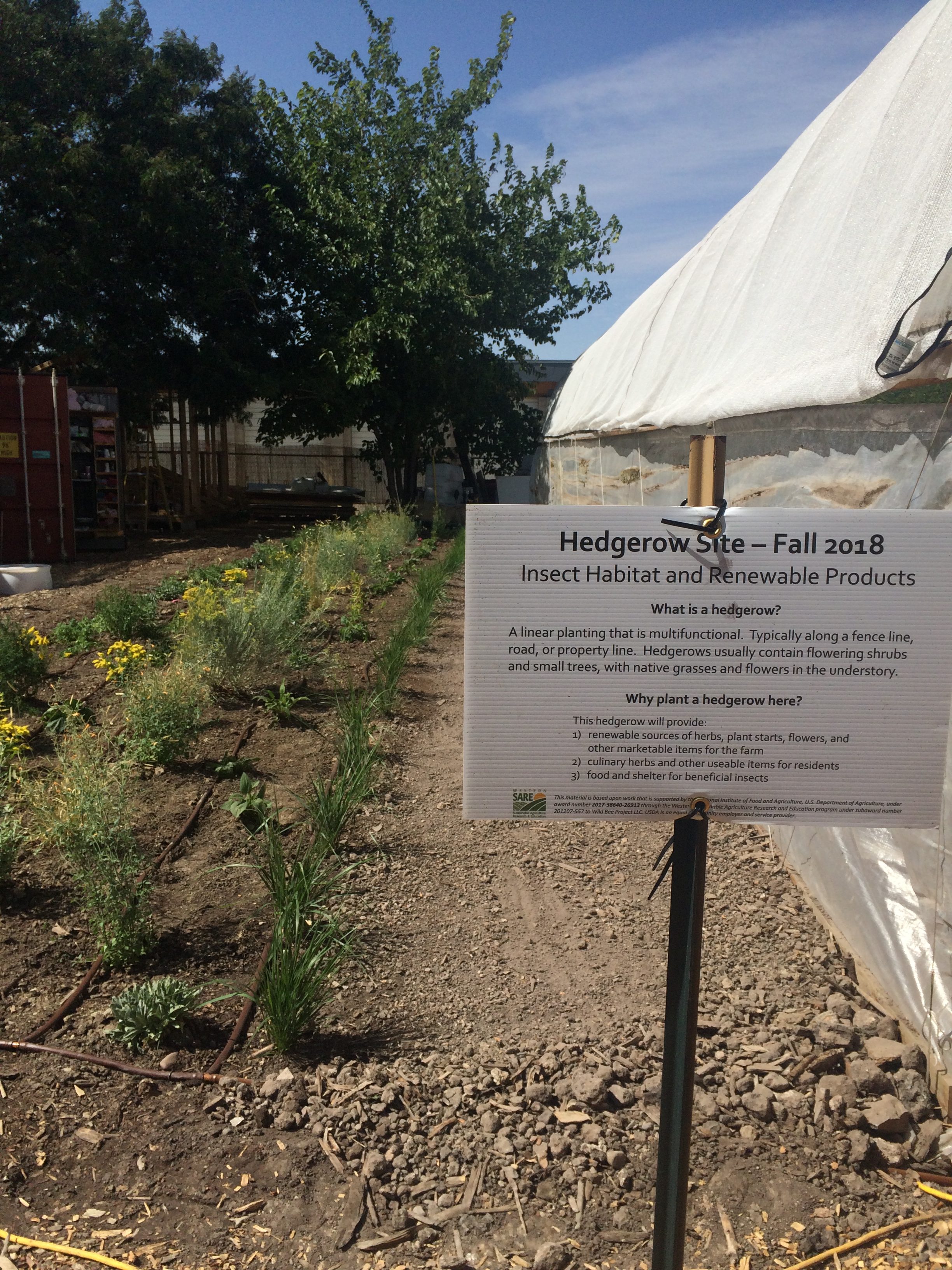
Site 2 (Hand Sewn Homegrown Farm) - FARMER/SITE ELIMINATED IN 2019
SPRING-FALL 2018
Site 2 (Hand Sown Homegrown Farm) A 80 ft x 4 ft block was chosen for the hedgerow, located between a fence and an open irrigation ditch that conveys water to the farm. The area was covered with turf grass and perennial weeds, having been mowed with a weed whacker several times per season. The hedgerow site is adjacent to the growing area, which is enclosed by the fence. A visual screen and windbreak is needed at the site to mitigate pests and weed seeds arriving by wind from the shared access road area and irrigation ditch along the south property line. Plant choices: flowering columnar shrubs and native bunchgrasses to fit in the narrow space and grow tall (8 ft) to provide a windbreak and visual screen in 3-5 years; also several flowering perennials planted in the gaps at each end of the hedgerow to attract and retain beneficial insects. FALL 2018: Site 2 (Hand Sown Homegrown Farm) To prepare the site, turf grass and weeds were removed by hand and approximately 1" of bark fines were spaded into the planting area. Plants were installed followed by installation of two Netafim irrigation lines (layout shown in photos). Species include black tower elderberry, golden tower elderberry, standing ovation serviceberry, little bluestem grass, blue gramma grass, echinacea, candytuft, black eyed susan, goldenrod, and autumn joy stonecrop.
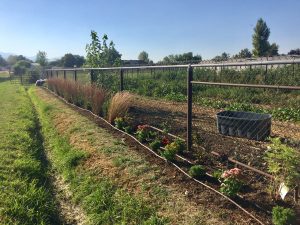
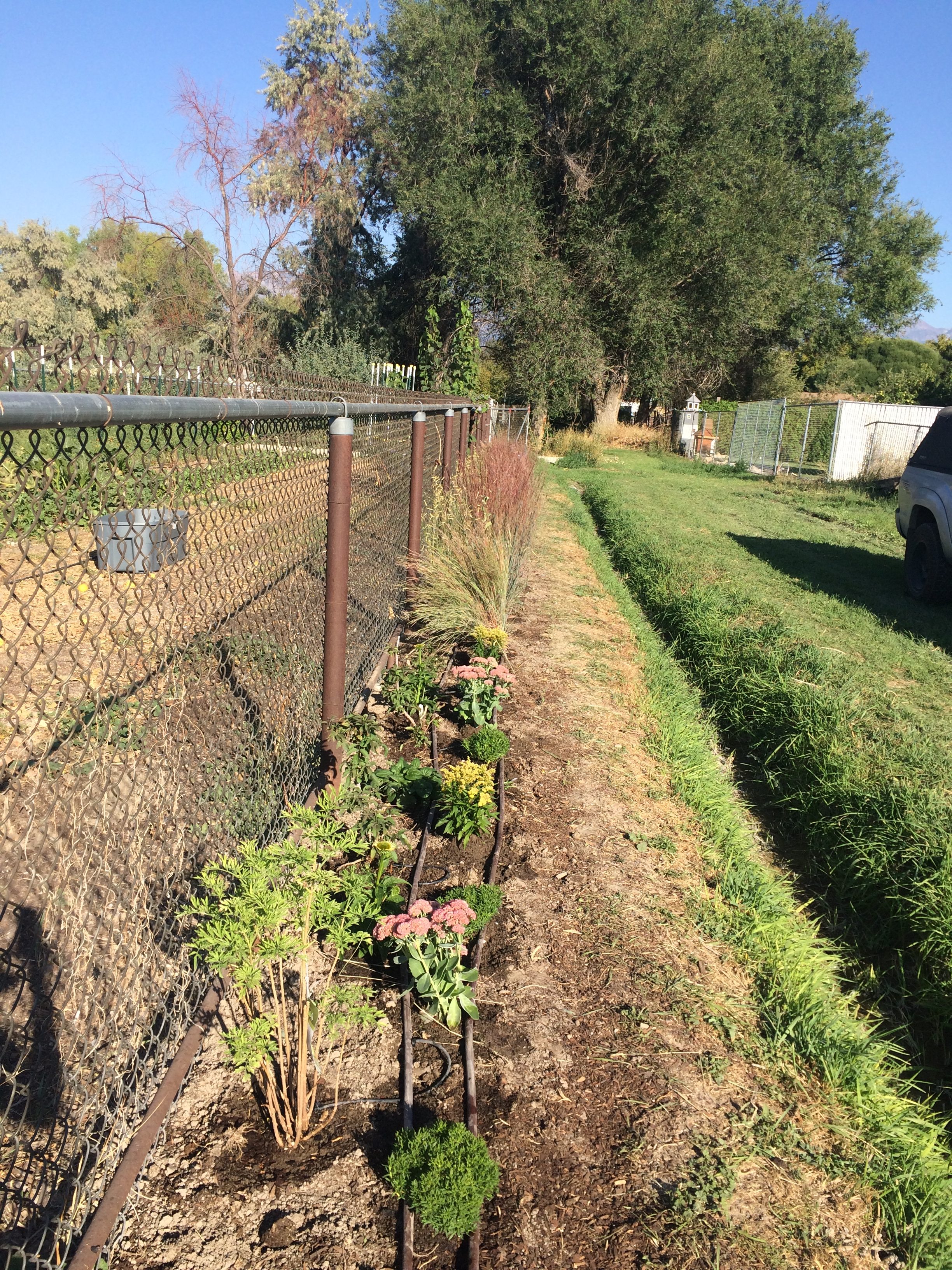
Site 3A (Wheeler Farm)
SPRING-FALL 2018
Site 3 (Wheeler Historic Farm) A 100 ft x 5 ft block was chosen for the hedgerow, which follows the edge of a historic farmhouse yard, and an irrigation ditch for part of its length (60 ft). The area had been bulldozed in 2017 for renovation of the historic farmhouse and garden, and was populated by some annual and perennial weeds. A hedgerow is needed as a living fence to enclose the historic farmhouse garden and provide stabilizing vegetation along the irrigation ditch. Plant choices: modern cultivars of traditional shrubs will be used, to aesthetically match the historic farmhouse, provide a realistic representation of a historic hedgerow, and provide recognizable species to the public for the "demonstration" objective.
FALL 2018: Site 3 (Wheeler Historic Farm) To prepare the site, weeds were removed by hand and approximately 2" of bark fines were spaded into the planting area. Plants were installed followed by installation of three Netafim irrigation lines (layout shown in photos). Species include knockout rose and Korean dwarf lilac for the shrub row and tufted hairgrass along the outside edge (the dark, uniform grass clumps shown in photos). Note: Existing perennial grasses (the lighter green, irregular clumps) immediately adjacent to the ditch were left in place to provide temporary stabilization while the tufted hairgrass becomes established.
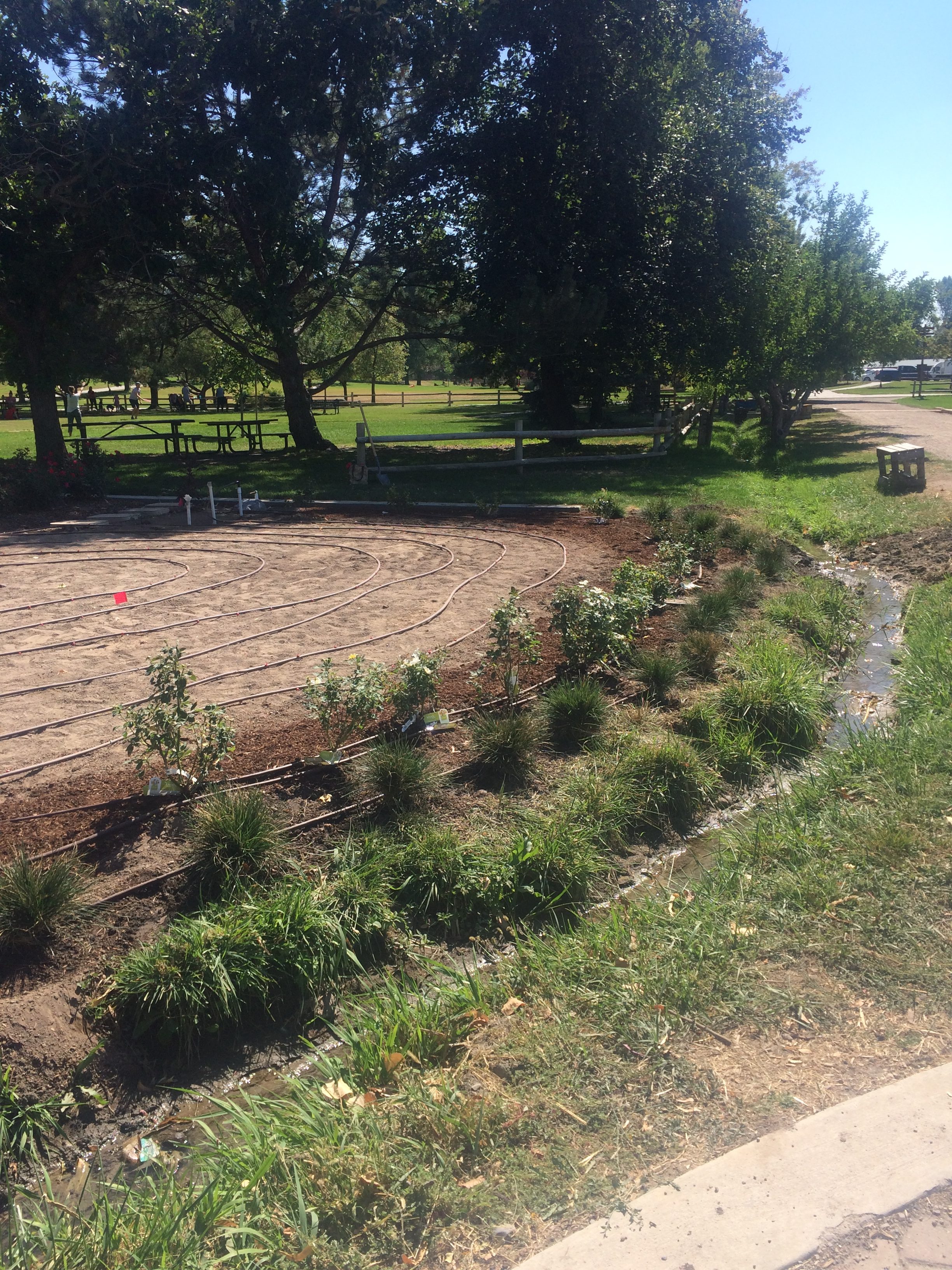
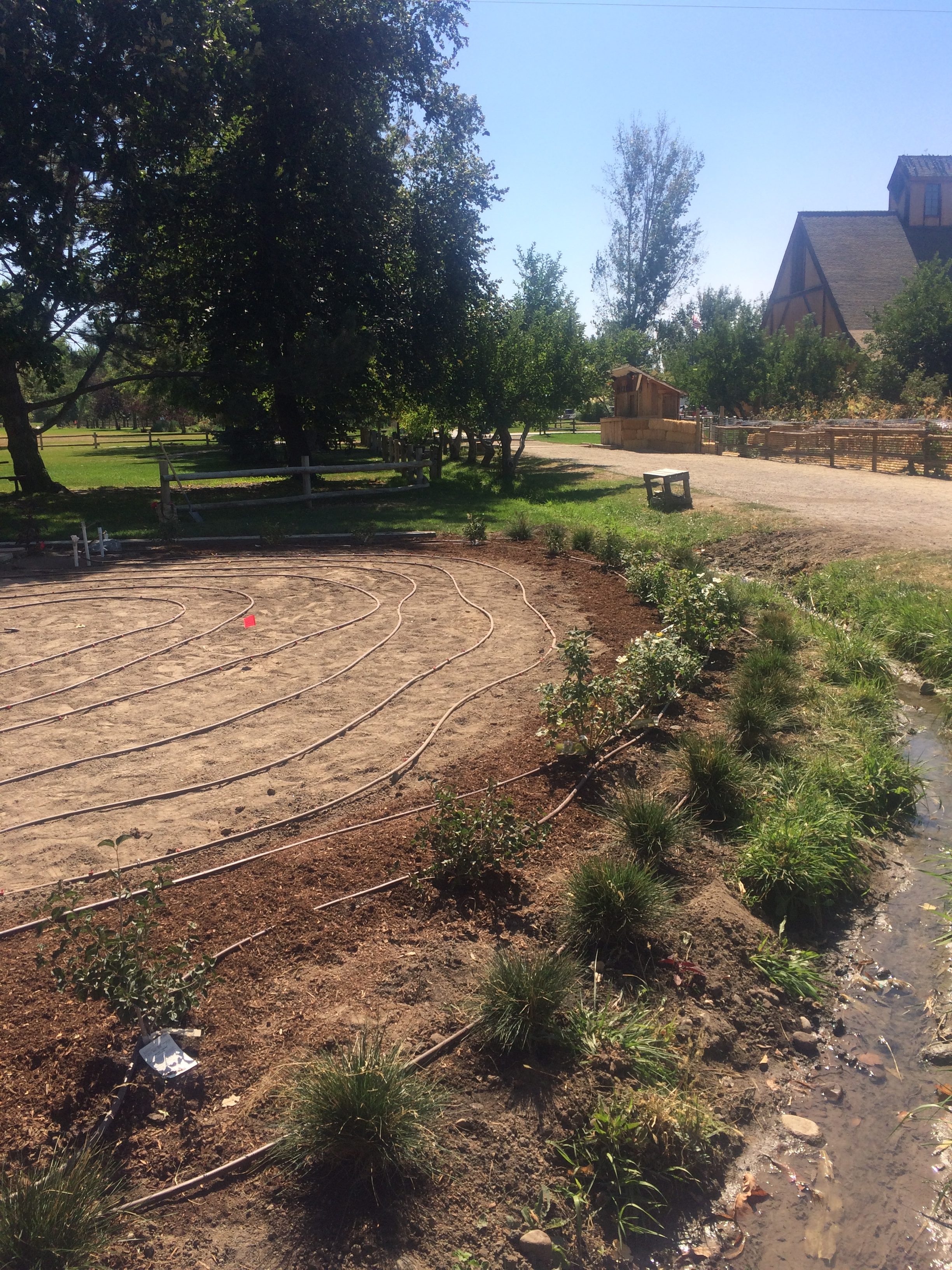
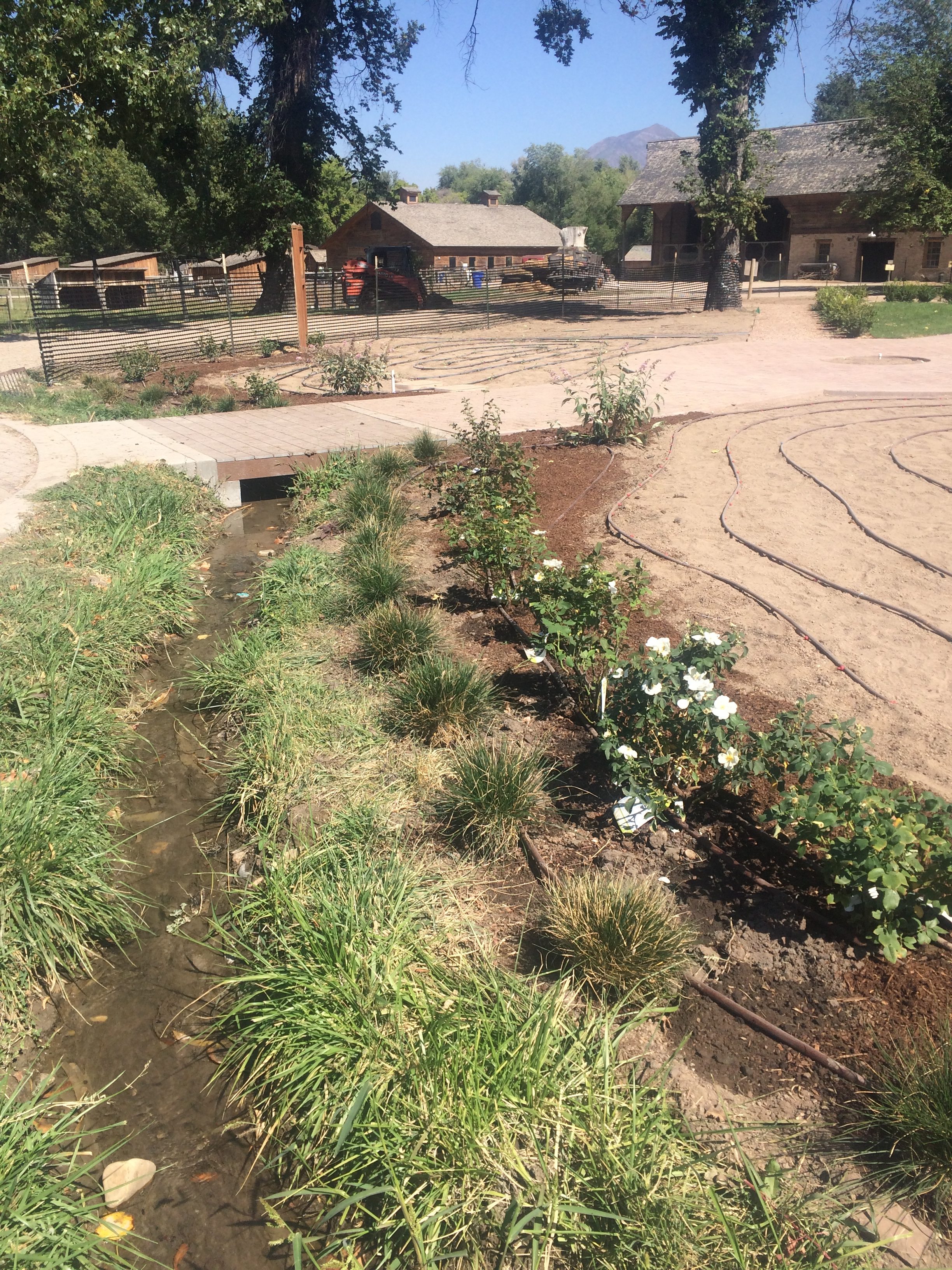
Site 3b (Wheeler Farm)
SPRING 2019
A 65 ft x 3 ft block was chosen for a second hedgerow, along the north margin of the main working field. This location would be adjacent to (north of) a row of blackberry brambles and was currently overgrown with perennial rhizomatous grasses and mowed regularly. The hedgerow was desired in this location to provide a visual and functional buffer on the border of the growing field. Plant choices: native bunchgrasses and cilantro (seeded).
To prepare the site, the row was tilled using a hand plow and soil was further turned by hand using shovels. Approximately 2" of bark fines were spaded into the planting area. Two species of native bunchgrasses (blue gramma and little bluestem) were seeded in the row in early April 2019 and covered with frost cloth. Cilantro and curly kale were seeded a few weeks later. The area was watered by hand when needed, then by overhead sprinkler starting in May.
Site 4 (Borski Farm)
SPRING 2019
A 80 ft x 4 ft block was chosen for the hedgerow, on the west side of a concrete wall / property barrier. The area had been weedy and unsuitable for growing vegetables and was a repository for field debris. Topography was flat although situated about 6 inches higher than the main field. The area was weeded by hand and mulched in fall 2018 in preparation for planting. A mix of hardy and drought-tolerant shrubs, grasses, and perennials were chosen.
To prepare the site for planting in 2019, the site was loosened with a broadfork and weeded although few weeds were present. Two lines of Netafim were laid, followed by plants over the next two days. Species included feather reed grass, blue gramma grass, blanket flower, candytuft, evening primrose, sage, basket-of-gold, blue flax, blue and red penstemon, butterfly bush, cinquefoil, red hot poker, rabbitbrush, catmint, alyssum, and goldenrod.
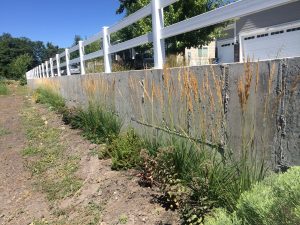
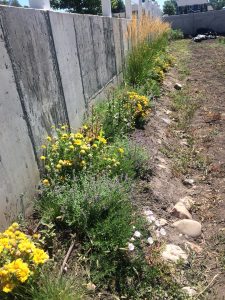 Hedge pictured in August 2019 (planting occurred in May).
Hedge pictured in August 2019 (planting occurred in May).
Site 5 (HHR Farm)
SPRING 2019
A 100 ft x 4 ft block, wrapping around three sides of the vegetable plot area, was chosen for the hedgerow. Fencing encloses the garden on these three sides, so the hedgerow site is just inside the fencing. Due to the high weed pressure at the site, only hardy flowering shrubs were chosen for the hedgerow in order to facilitate weeding until establishment. The site was mulched once and weeded by hand three times in 2018 and early 2019 in preparation for planting. In Spring 2019 two lines of Netafim were laid, followed by planting. Shrub species included golden currant, golden tower elderberry, standing ovation serviceberry, and two species of ninebark (a hardy ornamental).
Site 6 (Backyard Urban Garden or B.U.G. Farm)
FALL 2019
A 50 ft x 4 ft block along the east side of an existing cedar hedge at the western border of the farm was chosen for the hedgerow. The block was located three feet from the cedar hedge to minimize contact with the (possibly) acidic soils. The site had low weed pressure but was partially shaded at one end. Shade-tolerant shrubs were chosen for the shaded end, and a diverse mix of flowering shrubs and perennials were chosen for the remainder. The site was hand weeded, mulched, and loosened with a broadfork prior to planting. Two lines of drip tape similar to that used elsewhere on the farm were installed by the farmer prior to planting in early September 2019. Species included dwarf peashrub, butterfly bush, false spirea, Russian sage, and cinquefoil.
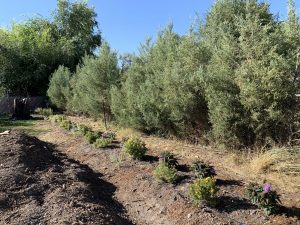
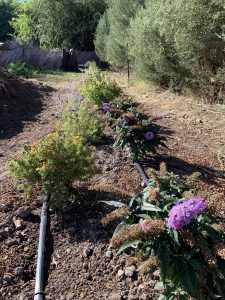 Hedge after planting, September 2019.
Hedge after planting, September 2019.
METHODS
2019 - 2020 DATA COLLECTION
(Objective 1b) Measure abundance and diversity of natural enemies on cole crop
2019 and 2020: Abundance of beneficial insects (ladybugs, hoverflies, and parasitoid wasps) was assessed on kale crops by visual count every other week at five sites in 2019 and four sites in 2020. Xerces Society protocols for "Traveling Count" or "Stationary Count" were used, depending on the collector's preference (count type remained consistent across collections for each collector). Data collection was interrupted when cole/brassica crops were covered or pulled out, or when weather was unsuitable. Hoverfly larva counts in 2020 were conducted during the hour before sunset when larvae were actively feeding.
Diversity: Voucher ladybug specimens were collected in 2019 using kill jars directly and identified by Laura Horn. All syrphid files were collected in 2019 and 2020 with an aerial net and identified by Laura Horn using a dissecting microscope (40x) and using Miranda et al. 2013. Voucher syrphid fly larvae were collected by Laura Horn and identified using Rotheray 1993. Approximately 200 parasitoid wasps were collected in 2019 via aphid mummies placed in Eppendorf vials and reared to adulthood; identified by Barb Sharonowski at University of Central Florida in 2021.
(Objective 2) Measure cabbage aphid infestation levels / crop losses due to aphids
To gauge perceptions, farmers were asked about their personal assessment of aphid infestation levels and kale crop losses (from cabbage aphid) in 2019 and 2020 via text, email, or in person. Farmer assessments were made at the end of each season.
Aphid infestation levels on kale crops were assessed weekly at five sites in 2019 and four sites in 2020. (Other brassica crops were also sampled in 2019 at Wheeler and Green Phoenix Farm.) A subset of five plants per brassica variety were chosen for aphid counts at each weekly assessment in 2019. A subset of ten plants per variety were chosen per week in 2020. Counts were conducted whenever it was not raining heavily. Counts were suspended when crops were covered or pulled out. In 2020, unexpected temperature drops and a hailstorm occurred on June 8th. We suspected that June data collection on beneficial insects, particularly for hoverflies, was affected negatively (i.e., lower than normal abundance) by these weather events.
In 2019 we counted aphids (Mean Number of Aphids per Leaf) on smaller plants by counting the total aphids per plant (if there were <20) or counting the number and size of all aphid clusters on the plant (# nail head size, # pinky nail size, # dime size, # quarter size) and dividing by the number of leaves. Cluster sizes (nail head, pinky nail, dime, quarter) were determined by collecting three representatives of each cluster size and counting the aphids using a dissecting microscope (then taking the mean for each "size"). We counted aphids on larger plants by first randomly picking three leaves ("upper" = leaf in the upper third, "middle" = leaf in the middle third, "lower" = leaf in the lower third) and conducting a similar count (as above) on each leaf, then taking the mean of the three leaves for "Mean Number of Aphids per Leaf."
After talking with farmers at the end of the season in 2019 we determined that a kale plant was "infested" when it had more than 5 aphids per leaf. This approximate 5 aphids per leaf is the economic threshold at which most farmers we worked with "hand harvest" (remove) infested leaves, which are not suitable for CSA or farmers market sales. We re-assessed the 2019 data using this threshold, to determine the percentage of plants each week that were "infested."
In 2020 we counted aphids using the economic threshold of 5 aphids per leaf, calling a plant "infested" that had an average of five or more aphids per leaf. Ten plants were assessed per variety, per week in 2020, to assess the number of plants that were infested. In this way we tracked the percentage of infested plants per variety each week.
In 2020 we collected data on aphid infestations between kale rows on the same farm, or by the same farmers at different sites (in the case of BUG Farm) when kale rows were different distances from the hedgerow. We did this at Green Phoenix Farm, BUG Farm, and Borski Farm. At Wheeler Farm, there was no other kale planted besides that within the hedgerow so comparisons could not be made. At Green Phoenix Farm, a row of russian kale was planted adjacent to the hedge, and the same variety of russian kale was planted about 50 feet away (within a row of mixed kales). At BUG Farm, a row of curly kale was planted about 20 feet from the hedgerow and the same variety was planted at a different property, without a hedgerow. Unfortunately frequent hand harvests at BUG Farm made data collection and comparison of infestation levels at these sites impossible, as plants were quickly hand harvested once they reached the threshold. At Borski Farm, three rows of kale, about 20 feet apart, were planted starting about 50 feet from the hedgerow. The closest row (Row 1) to the hedgerow was green curly kale, Row 2 was purple kale, and Row 3 was 50% green and 50% purple. We compared the green variety in Row 1 vs Row 3, and the purple variety in Row 2 vs Row 3.
RESULTS
Objective 1a: Establish hedgerows: COMPLETE. Hedgerows were established at 6 farms (Green Team/Phoenix Farm, Hand Sewn Homegrown, Wheeler Farm (2 hedgerows), Borski Farm, HHR Farm, and BUG Farm; demonstration sites in bold). 2020 Photos of demonstration hedgerows below:
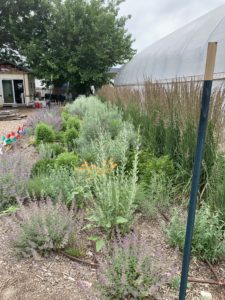
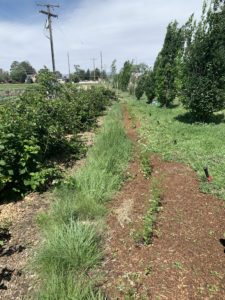
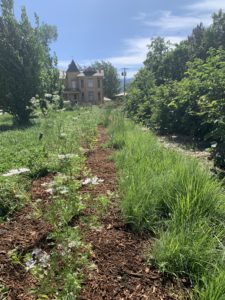
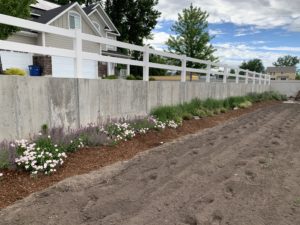
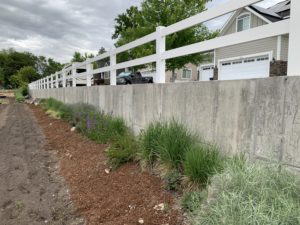
Objective 1b: Natural enemy abundance:
(4 Study Sites: Green Phoenix Farm, Borski Farm, Wheeler Farm, BUG Farm)
2019-2020
Data indicates that all three target natural enemies (hoverflies, ladybugs, parasitoid wasps) are present in low abundance across sites (less than one, or approximately one individual observed per minute by a stationary or walking observer). Isolated surges in natural enemies occurred only during aphid infestations in kale or other cole crops. Also, natural enemies were very rarely observed in hedgerows.
In aphid-infested kale or other aphid-infested cole crops, parasitoid wasps were the most consistent natural enemy, present during aphid infestations in moderate (approximately 5 individuals observed per minute) or high abundance (more than 10 individuals observed per minute) at all sites. Ladybugs were observed once per season in moderate-high abundance at each site (one ladybug surge during one aphid infestation at each site). All life stages of ladybugs (egg, larvae, adults) were present in moderate abundance during these aphid infestations. Otherwise ladybugs were observed in low abundance across sites. Syrphid fly adults, larvae, and eggs were present in low abundance during aphid infestations at all sites. During aphid infestations, syrphid fly adults were once present in moderate-high abundance (Green Phoenix Farm, early/mid May aphid infestation on 2nd year kale; 5-10 individuals per plant). Syrphid fly larvae at Green Phoenix Farm reached this "peak" abundance two weeks after a cabbage aphid infestation began on 2nd year kale in early/mid May, and this level of abundance appeared to be sufficient for total control of the cabbage aphid infestation within a few days as the infestation dropped to zero within this time frame.
An attempt was made in 2020 to compare syrphid fly abundance within different kale rows on the same farm, where kale rows were different distances from the hedgerow. Data was sufficient during aphid infestations, but little was collected outside of these times due to low abundance. Anecdotal results follow:
Green Phoenix Farm - Abundances of adult Eupeodes observed cruising (20-40%)-infested kale were similar (low abundance: one adult fly per minute) in both kale rows on June 1st. For the rest of June, after the weather events of June 8, adult Eupeodes were only observed occasionally feeding on nectar plants at Green Phoenix Farm (bolting brassica crops and cilantro). Starting July 7th, hoverfly eggs and Eupeodes larvae were observed only in the kale row adjacent to the hedgerow (where kale plants were at that time, 10% infested) and not at all in the kale row 50 feet from the hedgerow (where kale plants were 30% infested). Starting July 18th the kale row 50 feet from the hedgerow was hand harvested and plants were no longer infested. Hoverfly eggs and Eupeodes larvae were present on infested plants in the kale row adjacent to the hedgerow for the rest of July and through early August; then were no longer observed for the rest of the season.
BUG Farms - Abundances of Eupeodes hoverflies were different between kale rows at BUG Farm mainly because no hoverflies (adults, eggs, or larvae) were ever observed in at the site without a hedgerow. At the site with the hedgerow, Eupeodes adult hoverflies were present "cruising" the kale during the beginning of June (before weather events of June 8th) and for most of July. Eupeodes adults were consistently observed cruising kale plants (that were 0-20% infested) but always in low abundance (one adult per five or ten minutes) at the site with the hedgerow. Rapid hand harvests (when aphids appeared) at both BUG Farms sites affected the percentage of infested plants, AND probably affected the abundance of aphidophagous hoverflies. It should be noted that nectar plants for hoverflies (cilantro, alyssum, bolting brassica crops) were extremely abundant and consistently blooming at the site with the hedgerow (interspersed with crops, planted by the farmer). Hoverflies were only occasionally observed foraging on hedgerow flowers at BUG Farm (Potentilla, Sorbaria) and were most often observed foraging on the annuals mentioned above. The BUG Farms site without the hedgerow also had far fewer nectar plants - only a few volunteer cilantro and some buckwheat - which was about 10% of the amount of nectar plants present at the hedgerow site.
Borski Farm - Eupeodes hoverfly larvae were observed for three weeks in July at Borski Farm in Row 2 (purple curly kale, 30% increasing to 70% infested in three weeks) and Row 3 (green curly kale, 30% infested decreasing to 20% infested over three weeks), and hoverfly eggs were observed in Rows 1, 2, and 3 during this time. Eggs or larvae were scarce overall - one or two plants out of 10 sampled in each row contained either eggs or larvae during these three weeks in July. Adult Eupeodes were observed only in July at Borski Farm and very infrequently (one individual observed in 10 or 15 minutes).
Wheeler Farm - One Eupeodes hoverfly larvae and two eggs were observed on one infested kale leaf in mid July (kale plants adjacent to the hedgerow were 20-40% infested during July). Adult Eupeodes and larvae were observed frequently on infested cabbage and broccoli (both 100% infested) in the same field.
Objective 1b: Natural enemy diversity:
(4 Study Sites: Green Phoenix Farm, Borski Farm, Wheeler Farm, BUG Farm)
2019-2020
Parasitoid wasp mummies reared to adulthood (N=188) in 2019 from mummies on brassica crops were one of three types, from three different families. Sixty four (64) were Diaeretiella rapae (Braconidae), 106 were Alloxysta (likely) consobrina (Figitidae), and 18 were likely in the genus Asaphes (family Pteromalidae). Eighty four wasps were reared from mummies on kale; these results are presented below.
Table 1 Parasitoid wasp collections on kale in 2019 (N = 84). Number of specimens of each type by date is shown.
| Dates | Location | Variety | Diaeretiella rapae (Bracondidae) | Alloxysta sp (Figitidae) | Asaphes sp (?) (Pteromalidae) |
| April 8, 18 May 8 | Green Phoenix | Green curly (2nd year) | 31 | 0 | 0 |
| June 2, 12, 22 | Green Phoenix | Red russian (1st year) | 1 | 3 | 0 |
| July 8, 17 | Borski Farm | Green curly (1st year) | 3 | 9 | 4 |
| Sept 18 Oct 8, 18, 26 Nov 14 | Green Phoenix | Mix of Russian and lacinato (1st year several varieties) | 2 | 26 | 5 |
Identification of ladybugs indicates that diversity is low across sites (predominantly two exotic species: convergent lady beetle (Hippodamia convergens) and seven spotted lady beetle (Coccinella septempunctata).
Identification of syrphid flies indicates that one genus (Eupeodes) are consistently associated with cabbage aphid across sites. Adult male and female Eupeodes volucris and females of least one other Eupeodes sp. were identified (TABLE 1). Two other genera of syrphid flies with aphidophagous larvae (Toxomerus sp., Allograpta sp.) were observed at Wheeler and BUG Farm, but very infrequently: adults of these genera were observed in kale on three occasions (total) at BUG Farm in 2019 and 2020. These genera were observed on cilantro or alyssum at BUG Farm much more frequently than in kale, and were only observed on cilantro at Wheeler Farm (never in kale or other brassica).
TABLE 2 Types of adult hoverflies observed in kale crops - 2019 and 2020.
| Borski Farm | BUG Farm | Green Phoenix Farm | Wheeler Farm | |
| Eupeodes volucris | X | X | X | X |
| Eupeodes sp. (other) | X (1 or more sp) | X (1 or more sp) | X (2 or more spp) | |
| Toxomerus | X | |||
| Allograpta | X |
Only one genus was ever observed in cabbage aphid-infested kale (Eupeodes), and Eupeodes were observed very infrequently during the summer, when farmers have the biggest challenges with cabbage aphid. Summer aphid infestations in the few places they occurred (and were not managed immediately) did NOT attract more than one or two Eupeodes adults searching for oviposition sites and no Eupeodes larvae were never observed on aphid infested kale in the summer (of 2019 or 2020). The hope for 2020 was that non-Eupeodes aphidophagous hoverflies (Toxomerus, Allograpta) which appear only in summer, might show promise during the summer in being attracted to hedgerow plants or other nectar plants and perhaps show interest in laying eggs in infested kale. However, these species were only rarely seen during June and only in aphid-infested kale three times total.
The only hoverfly larvae that we ever observed feeding on cabbage aphid during this study were Eupeodes larvae. Hoverfly larvae collected at Green Phoenix Farm in May 2020 were identified as Eupeodes, 3rd stage larva. Larvae observed at Borski Farm appeared to have the same body shape, morphology, and coloration and were assumed to be Eupeodes 3rd stage larva. Larvae observed at Wheeler Farm appeared to be 1st or 2nd stage larvae and thus were too small to be identified using Rotheray (1993).
Objective 2: Aphid infestation levels:
2019
Three seasonal cabbage aphid infestation peaks were identified, one in early spring (consisting of overwintering/first generation aphids on 2nd year kale), one in mid-summer, and one in late fall. The mid-summer aphid peak (June - July) was identified as having the greatest potential for conservation biological control with an economic benefit and was the focus of the project in 2020.
2020
Question: Does kale planted closer to hedgerow have less (economically meaningful) damage from cabbage aphid?
Answer: Some anecdotal evidence (Green Phoenix Farm) suggests that kale planted directly adjacent to a hedgerow may have some protection from aphid infestation, compared to kale planted 50 feet away, in that kale adjacent to a hedgerow has a shorter and less severe aphid infestation. Post-infestation kale however does not have much economic value due to permanent aphid damage on the leaves.
**Unfortunately due to low incidence of cabbage aphid infestations in 2020, and prompt management of cabbage aphids where they occurred (hand harvests of infested leaves by farmers), only anecdotal observations can be reported on cabbage aphid infestations between kale rows at the same farm that were different distances from the hedgerow.**
At Green Phoenix Farm, I observed that when kale is planted directly adjacent to a hedgerow, cabbage aphid infestation appear to be of shorter duration and less severe than in a kale row of same variety that was planted about 50 feet from the hedge. When an aphid infestation in the row adjacent to the hedgerow was at 40% (approximately June 24 through July 3rd), Eupeodes larvae were observed in the row the following week (July 7th), and at that point the aphid infestation dropped to 10%. (This is an anecdotal observation of a correlation between hoverfly larvae appearing and aphid infestation subsiding.) Eupeodes larvae were not observed in the kale row 50 feet from the hedge, despite a 20-30% cabbage aphid infestation there. Hand harvests were performed in this kale row starting June 18th to remove infested leaves, and aphid infestations were not seen for the rest of the season in this row. (Hand harvests were not performed in the row adjacent to the hedgerow, and infestation levels remained at 10% of plants).
At Borski Farm, that when kale is planted in adjacent rows starting about 50 feet from the hedgerow, aphid infestation levels were similar in both varieties in Row 3 planted furthest away (90 ft from the hedgerow). Infestation levels appeared slighted worse for each variety when the kale was closer. Hoverflies were present in most of July, in low abundance.
| Date | Row 1 Green (50 ft from hedge) | Row 3 Green (90 ft from hedge) | Row 2 Purple (70 ft from hedge) | Row 3 Purple (90 ft from hedge) |
| June 19 | 10 | 10 | 0 | 10 |
| July 3 | 0 | 10 | 30 | 10 |
| July 9 | 0 | 0 | 30 | 0 |
| July 19 | 60 | 30 | 50 | 30 |
| July 25 | 40 | 30 | 70 | 30 |
| July 31 | 40 | 10 | 70 | 10 |
At BUG Farm, frequent hand harvests prevented aphid infestations from building up in either location where kale was planted.
Research Outcomes
Education and Outreach
Participation Summary:
- Tour of farmscaping elements at Green Team Farm, Salt Lake City, UT. Event = "Bee Fest, A Celebration of Pollination" June 16, 2018. Tour of Green Team Farm midway through the festival led by James Loomis (GT Farm Director), with approximately 5 participants who were farmers, included stops emphasized the multitude of existing beneficial insect plantings on the farm including the OW18-007 planned hedgerow site where Western SARE signage was posted.
- Workshop and tour of farmscaping elements at Wheeler Farm, Murray, UT. Event = "Urban Farming and Farmscaping Conference" August 30, 2018. Approximately 10 participants at the workshop were farmers. Approximately 5 farmer participants attended the farmscaping elements tour led by Laura Horn that emphasized the existing beneficial insect plantings including two planned installations funded by OW18-007 where Western SARE signage was posted.
- "Conservation Biocontrol" Presentation at Integrated Pest Management Workshop (hosted by USU Extension), West Jordan, UT, January 14, 2020. Laura Horn presenting to approximately 25 vegetable farmers about Conservation Biocontrol strategies followed by Q&A.
- Conservation Biocontrol article in Utah Pests Newsletter, Spring 2020 edition. Approximately 750 words written by Laura Horn, outlining Conservation Biocontrol strategies for Utah and progress on Western SARE project OW18-007.
